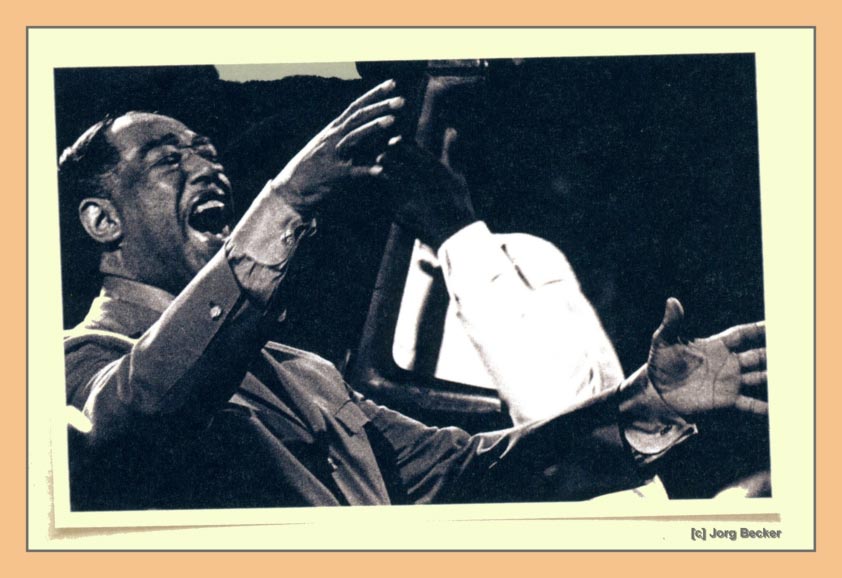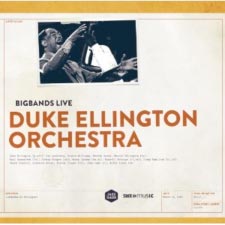Big Bands Live – Duke Ellington Orchestra – Live at Liederhalle Stuttgart, March 6, 1967, Jazz Haus 101-722
Recorded live at Liederhalle Stuttgart on March 6, 1967
Side a:
• Take The “A“ Train
• Johnny Come Lately
• Swamp Goo
• Knob Hill
• Eggo
Side b:
• La Plus Belle Africaine
• A Chromatic Love Affair
• The Shepherd
Duke Ellington (p, arr),
Cat Anderson, Cootie Williams, Herbie Jones, Mercer Ellington (tp),
Paul Gonsalves (ts),
Johnny Hodges (as),
Harry Carney (bs, cl),
Russell Procope (cl, as),
Jimmy Hamilton (cl, ts),
Chuck Connors, Lawrence Brown, Buster Cooper (tb),
John Lamb (b),
Rufus Jones (dr)
I feel like I should be able to say “just buy this album” and you would take my word, that you already were fully invested in the Ellington method, ethics, creative processes, coolness, hotness, power, precision, passion, pride and vision that made him a giant of 20th century American music. Though Armstrong would definitely have something to say about it, Ellington was the man most responsible for making “race music” acceptable in white America, and making Jazz, then other “race music,” main stream. The blues artists certainly didn’t cross over, and rock and roll didn’t come along until years after Ellington made his debut in front of the exclusively white Cotton Club, while going out to radio listeners everywhere. Ellington had to deal with the oppression in subtle ways. So, while appearing as a member of “the orchestra,” he presented a figure that was as regal as his title suggests.
The most remarkable achievement by Ellington was the continuous high level of play. It’s not unusual for an act to shine brightly for a few years, then fade quickly. Imagine the boxer who could win the championship at the ages of 20, 30, 40, 50, 60 and 70. Ellington was active for 60 years, and at a consistently high level for over 50 years.
He was 67 when these recordings were made, seven years before his death in 1974. Compared to recordings 20-30 years previous, the band isn’t as “tight,” but this has more to do with the aging process than some dereliction of duty on the part of Ellington, or his band members. Some of the tightness is replaced with a more relaxed, harder swinging style, which breathes life into some pieces (Ellington could border on the ascetic at times).
The Tunes
The concert begins with “Take The ‘A’ Train,” his most popular song in the ‘60s. It’s kind of like the “Can’t Turn You Loose” set-opening tune the Blues Brothers made famous. It’s not really a creative product. It’s a calling card.
“Johnny Come Lately” was a tune I hadn’t listened to in years, but it still fits like an old shoe. The hook is memorable, and the tune is jaunty. The bari sax solo by Harry Carney is awesome (ditto all other Harry Carney solos—nobody sounds like Harry Carney; his sound is a giant sequoia splintering in the middle of an earthquake). The tune and the arrangement are vintage Strayhorn and Ellington.
“Swamp Goo” seems like a hybrid (the musical equivalent of a gasoline-electric hybrid car). The opening shows influences by the late ‘60s Blue Note Boogaloo records. It’s funky and urban, and then it abruptly goes back 30 years to the Bubber Miley “Jungle Music” style. It’s quite an adventurous segue. There’s a concise and economical solo by the Duke, and the first of many excellent clarinet solos on this LP.
“Knob Hill,” like “Swamp Goo”, has a contemporary (for the times) opening, but like “Swap Goo,” it then shifts gears to vintage Ellington, with an indefatigable tenor sax solo by Paul Gonsalves. Both tracks show that Ellington’s orchestra could play any style it wanted, though it preferred the Ellington style (which was not just Ellington’s sound, but Strayhorn’s and the musicians’ sound).
“Eggo” is brilliant ensemble work with another fine clarinet and bari sax solo. The unison playing of the band, though not quite the equal of younger versions of the Ellington orchestra, is miles ahead of Kenton, Basie, etc.. This level of precision takes years of practice, a feel for your band mates, a close mental connection between musicians and the leader, and complete control over your instrument (much like a gymnast’s control over her body).
Side two, with more adventurous and challenging material, opens with “La Plus Belle Africaine.” I wrote down “Indian/African,” meaning, I think he was using a few Hollywood “Indian chords.” There is incredible power, like a marching band chart. The lively percussion intro is followed by piano and unison brass, and at times slightly atonal bass solo is followed by one of Harry Carney’s most progressive solos (I’ve heard): expansive, tall and confident, with incredible power, enough to match the rest of the band. The solos finish with another great clarinet solo, by Jimmy Hamilton, this one fleeting and elegant, gliding over the background like a canoe over rippling water.
“A Chromatic Love Affair” features another delightful solo by Harry Carney on Bari Sax. His power is on full display. Massive shifts in volume, register, timbre and a fine example of circle breathing. Carney and Ellington were close friends. Carney would die just four months after Ellington. Without the brain and the underpinnings, the band ceased to exist.
The final tune is “The Shepherd”, has an arduous trumpet solo by Cootie Williams. There are hints of “Minnie the Moocher”.
The Sound & The Verdict
The sound is not quite “purist” (in the strict audiophile idealization of recording practices), with the use of “spot mics”, mixed with stereo mics. However, the mix is tasteful, with ample amounts of concert hall ambience. The frequency response is very good, with solid bass, and extended overtones. There is good stereo imaging when the whole band is playing. Overall, the sound is consistent with “best practices”, and stands comparison to most big band recordings. While a purist approach would be commendable, I would rather hear the many fine solos in detail, along with good ensemble sound. So, I cannot argue with the recording engineer. He does a superb job.
Of the Jazz Haus releases, this one is my favorite. I suppose there are plenty of people who dislike “big band,” but please try to get over the “big band” appellation. The Ellington Orchestra was a collection of some of the finest musicians in the land, ever to walk it. Ellington knew very well how to juxtapose the improvisation abilities of the individual members, with his composed and orchestrated ensemble playing. Think of Ellington’s Orchestra as more like a sports team that plays great “team ball,” but with star players who could “put the team on his back”. And Ellington was the Connie Mack of band leaders, though Ellington’s winning percentage was higher.
With excellent sound, brilliant playing, and interesting selections, this album is necessary for anyone considered a jazz collector and audiophile, not just for Ellington completists. Amazing and necessary music.
- (Page 1 of 1)


